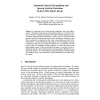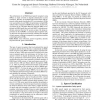106 search results - page 7 / 22 » Performance estimation of noisy speech recognition consideri... |
ICASSP
2011
IEEE
12 years 11 months ago
2011
IEEE
Speech inversion is a way of estimating articulatory trajectories or vocal tract configurations from the acoustic speech signal. Traditionally, articulator flesh-point or pellet t...
ICASSP
2011
IEEE
12 years 11 months ago
2011
IEEE
Phoneme posterior probabilities estimated using Multi-Layer Perceptrons (MLPs) are extensively used both as acoustic scores and features for speech recognition. In this paper we e...
MLMI
2005
Springer
14 years 1 months ago
2005
Springer
Abstract. An important step to bring speech technologies into wide deployment as a functional component in man-machine interfaces is to free the users from close-talk or desktop mi...
INTERSPEECH
2010
13 years 2 months ago
2010
The performance of an HMM-based speech recognizer using MFCCs as input is known to degrade dramatically in noisy conditions. Recently, an exemplar-based noise robust ASR approach,...
KBS
2006
13 years 7 months ago
2006
Spoken dialogue systems can be considered knowledge-based systems designed to interact with users using speech in order to provide information or carry out simple tasks. Current s...


